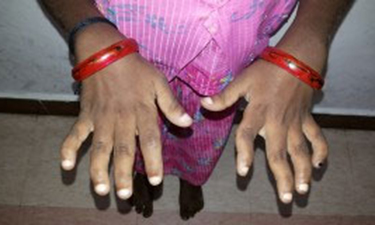
Cause:
Chikungunya is a virus that enters the blood stream of humans when bitten by an infected mosquito. Once the virus enters the body, intense inflammation sets off causing high fever, chills, back pain and severe acidosis presenting as whole body pain, back pain,giddiness and inability to walk. Face appears red and flushed. (in some parts layman call it tomato fever as the patient looks like a tomato) It appears that the virus has a liking for the tissues such as the joint, tendon, muscles and occasionally fat.The fever subsides in 3-5 day. The joint pain may last 5-7 days. Sometimes a red rash all over the body with itching is observed around the fifth day and lasts 3 days. As rash occurs while the patient is on treatment it is commonly mistaken for drug allergy. I therefore routinely advise my patient that they may develop rash because of the virus and not the drug. Joint pain slowly subsides in 10-12 days only to recur around the 23rd -25th day after fever. This is because of the immune response to the virus. This pain occurs in fingers, ankle, knee and lasts 2-4 months. In some, it comes under control with pain killers (NSAIDs),others may need low dose steroids about 5 mgs of prednisolone. Ankle swelling is very common. (Always wondered if that was the site of mosquito bite). Some patients also develop a red patch in their leg called panniculitis which is inflammation of the fat and mimic’s cellulitis (skin infection). This may require short course of steroids, but leaves behind skin darkening and some fat loss.
Diagnosis:
There are no diagnostic tests. Chikungunya IgM is a blood tests that measures the immune response to the virus. It takes about 7-10 days for the IgM levels to increase and be detected in the blood. Hence this test must be done about 8 days later. The test will be negative if done within 2-3 days of fever. Usually the patient is better by 8 days so the test is not routinely done. Also the test is positive in only about 60-70% of the patients and one in three patients may not test positive . During the fever, because of the intense inflammation the total count and platelet count may be low, but resolves spontaneously over a week. CRP an inflammatory marker is very high and subsides in 2 months.
Management:
Anti-inflammatory drugs are very helpful and quickly reduces the pain and discomfort. Occasionally steroids are required. Antihistamines (allergy tablets) may be required for 3-4 days to reduce the itching associated with the rash. If pain persists beyound 3 months or joints continue to remain swollen on drugs certain medications such as hydroxychloroquine, sulfasalazine may be used. Majority of the patients are off all medications by 4-6 months. A small proportion may need medications for prolonged periods. Supportive acidity reducing medicines and calcium are administered with pain killers or steroids.
